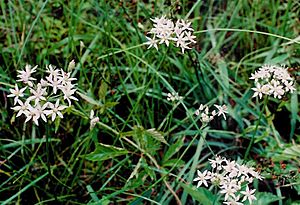Little River Canyon Onion facts for kids
Quick facts for kids Little River Canyon Onion |
|
|---|---|
 |
|
| Allium speculae in DeKalb County, Alabama | |
| Scientific classification |
The Little River Canyon Onion (scientific name: Allium speculae) is a special type of plant. It is a wild onion that grows naturally in the U.S. states of Georgia and Alabama. You can find it especially near the Little River Canyon National Preserve in northeastern Alabama. This plant likes to grow in sandy and rocky soils. It lives in a hilly area called the Piedmont region, usually at heights of about 300 meters (about 984 feet) above sea level.
What Does the Little River Canyon Onion Look Like?
The Little River Canyon Onion has parts that look like regular onions.
Its Underground Parts
- This plant grows egg-shaped bulbs. These bulbs can be up to 5 centimeters (about 2 inches) long.
- Unlike some other plants, it does not have special underground stems called rhizomes.
Its Stems and Flowers
- The plant has tall, round stems called scapes. These scapes can grow up to 30 centimeters (about 12 inches) tall.
- Its flowers are shaped like small bells. They can be up to 6 millimeters (about 0.24 inches) wide.
- The flower petals, called tepals, are usually pink.
- Inside the flowers, the parts that hold pollen (anthers) and the pollen itself are a pale yellow color.
- The part of the flower that develops into a seed (the ovary) has a small crest or ridge on top.

All content from Kiddle encyclopedia articles (including the article images and facts) can be freely used under Attribution-ShareAlike license, unless stated otherwise. Cite this article:
Little River Canyon Onion Facts for Kids. Kiddle Encyclopedia.
